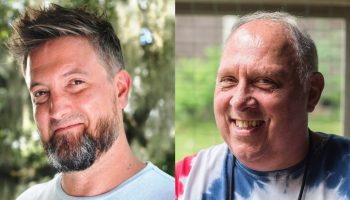When neuroscientist Peter Strick hears someone say, “It’s all in your head,” he answers, “Your brain is in your head.”
And your brain is connected to your immune system, as well as your muscles, heart, kidneys and other internal organs.
“I’m not saying that you can think your way out of cancer, but that you can influence your immune system by how you think and what you do,” said Strick, the founding scientific director of the Brain Institute and the director of the Systems Neuroscience Institute at the University of Pittsburgh. “Three years ago I would have been the last person to say this.”
At 3 p.m. Saturday in the Hall of Philosophy, Strick will discuss “Your Brain in Action.” His talk will be the Contemporary Issues Forum’s third annual Barbara Vackar Lecture.
Cathy Bonner, chair of the Chautauqua Foundation, established this annual CWC lecture series in honor of fellow Texan Barbara Ellison Vackar. Vackar was president of the Chautauqua Women’s Club from 2005 to 2010, special assistant to former President Jimmy Carter in the late 1970s and director of Texans for ERA (Equal Rights Amendment) earlier in the 1970s.

Ever since Strick was a biology major at the University of Pennsylvania, he has been thinking big about the human brain.
“I was bored in a world history class and thought about the notion that I could move my finger whenever I want to,” he said. “How? What’s the nature of volition? Where does this energy come from?”
Strick remained at the University of Pennsylvania, earning his Ph.D. in neuroanatomy and neuroscience. During his four-year postdoctoral fellowship at the National Institute of Mental Health, he learned neurophysiology.
In 1976, he began a 24-year association with the departments of neurosurgery and physiology at the SUNY Upstate Medical Center, where he became a full tenured professor, and the Veterans Administration Medical Center in Syracuse.
Because “no single discipline can make sense of the brain; it requires a multidisciplinary approach,” Strick has been actively engaged in continuously learning about one brain-related field after another throughout his career. For example, he co-founded the Society for the Neural Control of Movement, an international community of scientists, clinician-investigators and students.
With a collaborative spirit in mind, he moved to southwestern Pennsylvania in 2000 to join the University of Pittsburgh’s departments of neurobiology, neurological surgery, physical medicine & rehabilitation and psychiatry.
When he came onboard at Pitt, he also assumed the role of co-director of its Center for the Neural Basis of Cognition, a joint venture between Pitt and Carnegie Mellon University.
Pitt’s “open academic architecture” promotes cooperation and collaboration across disciplines and organizations, and with nearby universities.
“I truly believe in multidisciplinary research,” Strick said. “There’s no one way to understand brain research. To paraphrase Hillary, it takes a community.”
In 2012, Strick was named the Thomas Detre Professor and Chair of the University of Pittsburgh’s department of neurobiology, and appointed the co-director of its Center for Neuroscience.
Two years later, he co-founded the Brain Institute, a unifying structure that brings together researchers throughout Pitt’s numerous neuroscience research centers and programs. Its purpose is to use basic scientific research to understand normal and abnormal brain function and develop approaches for overcoming brain disorders.
Like the blind Indians looking at the elephant, Strick said he could go department-by-department, school-by-school at Pitt.
“What I wanted to promote is the sum being more than the parts,” he said. “There are about 150 scientists at the university doing brain research. (The Brain Institute) is getting people out of their labs and offices, which is what institutions need to promote.”
Science isn’t done by departments, Strick continued.
“You do it by having scientists next to each other,” he said. “There are loads of studies (showing that) you promote collaboration by getting people in the same room.”
Like Bell Labs, he wants to “promote opportunities for discovery” by giving scientists — “the best and the brightest” — the chance to do basic research without the tunnel vision and missed opportunities associated with narrowly testing hypotheses.
According to Strick, 96 percent of brain research is done on rodents, even though they are missing portions of our brain.
“If you want to understand humans, you need to study humans and other primates.” he said. “There’s something special that enables us to be human.”
When it comes to the brain, much remains to be discovered.
“We don’t know the brain’s wiring diagram,” Strick said. “Imagine if you go to your car repair shop and they can’t fix it because they don’t have your car’s wiring diagram. When we learn about (the brain’s) wiring diagram, it provides us with some very important insights into the brain and behavior.”
For example, there are brain regions that are important in controlling stress, Strick said.
“Is there any reason they have an impact on stress?” he said. “The only way to put them on a firm scientific basis is (to produce) the wiring diagram. That’s part of the reason I do anatomy.”
Strick’s own research has focused on the following four areas: the motor areas of the cerebral cortex; the motor, cognitive and affective functions of the basal ganglia and cerebellum; the neural basis for the mind-body connection; and the complex neural networks that comprise the central nervous system.
Part of Strick’s research concerns the brain-body connection.
“How we think, move, feel has a real impact on the function of our internal organs,” he said. “It is the basis for psychosomatic and complementary (alternative) medicine. In the past, I might have been one of the first to poo-poo the brain-body connection, but it’s real.”
Remarkably little is known about how the brain produces behavior, Strick said.
“Every cell in our body has the same DNA material. … The (gastrointestinal) system retrieves nutrients from food, but the brain produces behaviors, speech, thought, consciousness,” he said. “We’re really only scratching the surface about how it accomplishes these feats. … I still marvel at the brain.”
At Chautauqua, Strick wants to give people an idea of all the things the human brain can do, in part because “we don’t spend a lot of time marveling at what the brain does,” including reading and writing.
“The brain is unique,” Strick said. “We can replace a kidney, we can transplant a heart, we can get along okay without a spleen, but we cannot replace a brain.”
The brain is also difficult to repair, even though it has a “repair shop” that performs “housekeeping” tasks such as “tuning,” which people are unaware of.
“We can’t cure polio; we vaccinate against it,” he continued. “Rabies is a neurotropic virus (it infects nerve cells). There’s no cure, and if someone contracts it, no treatment. So again, we vaccinate.”
Using demonstrations, he will show brain plasticity — the ability of the brain to change throughout life.
“At any age, as long as your cerebellum is functioning, you have the ability to adapt,” Strick said. “The brain is constantly taking in information about motor and cognitive output, but there are limits to that adaptation. … We can’t fix what’s been broken.”
People’s actions can adversely affect the brain. Children would have better outcomes in school, for instance, if we could convince women not to smoke or drink alcohol during pregnancy, he said.
“What is there left to explore?” Strick said. “People talk about outer space — flying to Mars. But what’s inside our heads?”




